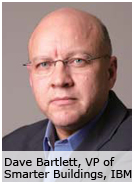Newer physical security products are made and used with energy conservation in mind.
Continued efforts in R&D for products that utilize renewable energy sources while preventing excessive power usage have their role to play in ensuring a longer living earth.
Newer physical security products are made and used with energy conservation in mind. Continued efforts in R&D for products that utilize renewable energy sources while preventing excessive power usage have their role to play in ensuring a longer living earth.
CONTRIBUTING TO LEED
Many security electronics, sensors, detectors, access control devices and surveillance cameras can be designed and implemented to help meet LEED certification by understanding the characteristic of the buildings and the potential energy saving of each end user. “Most energy consumption in the building, which is generally around 60 percent, is used by HVAC and other electricity and water usage,” said Vincentius Liong, Director of Integrated Security System Solutions, Elektrodata Sistem Integrasi. “By implementing the proper security equipment product range — sensors and detectors, access control, surveillance cameras with motion detection, and more — integrated with the building automation system (BAS), a building manager could properly control, manage and monitor the usage of energy, electricity and water usage in the building.”
Physical security systems contribute to the BAS in terms of locating people in a building with efficient access control and occupancy sensors to determine the headcount per floor or per zone, said David Wilts, Director of Integrated Building Technology, Crestron Electronics. “We have worked on many projects where the occupancy sensor in the conference room turns the lights and AV system on and off, recalls shade settings, adjusts the set-point for the local thermostat, and tells the calendar application whether or not people showed up for the meeting. If no one showed up for the meeting, the room automatically became available again in the calendar.” There is a large opportunity to leverage the security system for energy efficiency and LEED efforts.
“LEED recognition does help keep an eye on the quality of products used to achieve green building goals,” said Peter Boriskin, Director of Product Management, UTC Fire & Security. “Efforts like LEED will become even more established and widespread in the near future to help initiate more green building projects and awareness.”
POWER BACKUP MEASURES
 Shutting off power to conserve energy directly outside peak hours is common in green buildings. Temporary electricity suspension in response to excessive power usage or natural disasters is also a more frequent occurrence nowadays. Unfortunately this interregnum cannot happen to a reliable and active surveillance system, as emergency situations could happen any time. Security solutions must have a backup power mechanism, like an uninterruptible power supply (UPS), or else they fail in their foremost function, said Dave Bartlett, VP of Smarter Buildings, IBM.
Shutting off power to conserve energy directly outside peak hours is common in green buildings. Temporary electricity suspension in response to excessive power usage or natural disasters is also a more frequent occurrence nowadays. Unfortunately this interregnum cannot happen to a reliable and active surveillance system, as emergency situations could happen any time. Security solutions must have a backup power mechanism, like an uninterruptible power supply (UPS), or else they fail in their foremost function, said Dave Bartlett, VP of Smarter Buildings, IBM.
City code requirements of backup measures in smart buildings are essentially the same as traditional buildings. “In terms of what is available beyond regulated by the codes, typically a backup system would leverage the building's energy generating system,” Boriskin said. “There is more adoption of solarpowered cameras, especially in remote locations, which conserves energy usage as well as providing the power needed.”